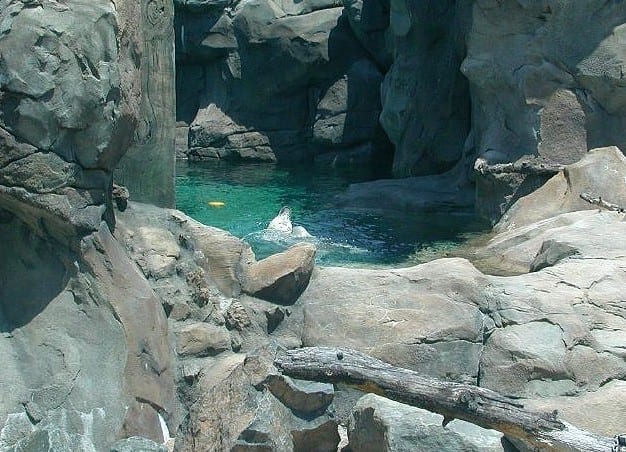Zoological Construction – Recreating a Natural Habitat
Posted in News -

The experience that one gets while viewing an animal in a caged enclosure verse observing one in its natural habitat can not be compared. This is why zoological architects call upon the skills of themed construction practitioners to recreate a natural habitat that meets the needs of each individual creature. Unlike the tight quarters of a caged pen, these animal containment facilities let the animals roam freely in a large surrounding that best resembles their natural habitation.
Highly skilled artisans and themed construction personnel employ both conventional and non conventional materials to reproduce and enhance each animal containment facility that they build. A deep understanding and respect for the animals that are being placed into the exhibit is a must so that extreme measures can be taken to ensure a safe habitat for each individual creature. Furthermore, each containment facility should also be designed to engage zoo patrons, in an attempt to help them better understand wildlife and the challenges of preservation and conservation.
 Over the past couple of decades zoo exhibit construction has been in demand requiring full service zoological exhibit contractors. The Campo Gorilla Reserve at Los Angles Zoo and Botanical Gardens is a perfect example of a natural lowland gorilla’s containment facility with rock work, vegetation and a monolith mud bank that keeps the gorillas enclosed yet provides an exhibit that gives visitors the opportunity to view their natural behavior. To turn this species specific enclosure into a reality a skilled zoological construction team had to develop a keen understanding of the gorilla’s natural habitat in the wild along with their sense of territoriality, forging habits and physical capabilities.
Over the past couple of decades zoo exhibit construction has been in demand requiring full service zoological exhibit contractors. The Campo Gorilla Reserve at Los Angles Zoo and Botanical Gardens is a perfect example of a natural lowland gorilla’s containment facility with rock work, vegetation and a monolith mud bank that keeps the gorillas enclosed yet provides an exhibit that gives visitors the opportunity to view their natural behavior. To turn this species specific enclosure into a reality a skilled zoological construction team had to develop a keen understanding of the gorilla’s natural habitat in the wild along with their sense of territoriality, forging habits and physical capabilities.
It is important for zoo exhibit builders to take all of these factors into consideration when building a habitat that will ensure the survival of an endangered animal.
 Another zoo construction project that rendered a wonderful and exhilarating exhibit both for the animals and the visitors is at the Maryland Zoo Polar Bear Watch. You will have a hard time convincing these polar bears that the Maryland Zoo is thousands of miles from the artic because their containment facility is a mirrored image of where their ancestors and extended family continue to forage for food along the ice capped artic coastline.
Another zoo construction project that rendered a wonderful and exhilarating exhibit both for the animals and the visitors is at the Maryland Zoo Polar Bear Watch. You will have a hard time convincing these polar bears that the Maryland Zoo is thousands of miles from the artic because their containment facility is a mirrored image of where their ancestors and extended family continue to forage for food along the ice capped artic coastline.
Revolutionary projects like these have assisted in pioneering the truly amazing experience that visitors are akin to at the modern zoological parks and gardens today. With one of a kind rockscapes and pools of water managed by Life Support Systems (LSS) that ensure the survival of animals, zoo patrons are able to observe the remarkable behavior of exotic creatures as they roam around their habitat.
 Creating natural habitations with Life Support Systems that are used to contain animals or ocean life at zoological parks and aquariums begins with scaled models based upon specifications provided by architectural drawings. Each one of these models is then used to properly execute the zoo exhibit construction process. Natural and artificial rock work, along with customized earth bank textures, water features, faux trees and decorative coral inserts are a few of the features used within these different zoological exhibits.
Creating natural habitations with Life Support Systems that are used to contain animals or ocean life at zoological parks and aquariums begins with scaled models based upon specifications provided by architectural drawings. Each one of these models is then used to properly execute the zoo exhibit construction process. Natural and artificial rock work, along with customized earth bank textures, water features, faux trees and decorative coral inserts are a few of the features used within these different zoological exhibits.
Some projects are large scale and some are simple and unique, however it is important to remember even the simplest of projects contain advanced structural and environmental management systems and technology.
If you are interested in finding out more about constructing a natural habitat at a zoo or zoo construction companies, contact info@otl-inc.com for more information.
Featured Articles
- Getting to Know OTL’s Administrative/Accounting Assistant Nathan Touche
- Centers With Well-Designed Experiential Water Features Can Attract 30,000 Visitors Per Week
- Fountains of Light: California Water Features Developer Opens North Texas Office
- AI and Facility Management: How to Avoid Potential Pitfalls
- Safety First and Last: Creating a Safe Site in any Environment